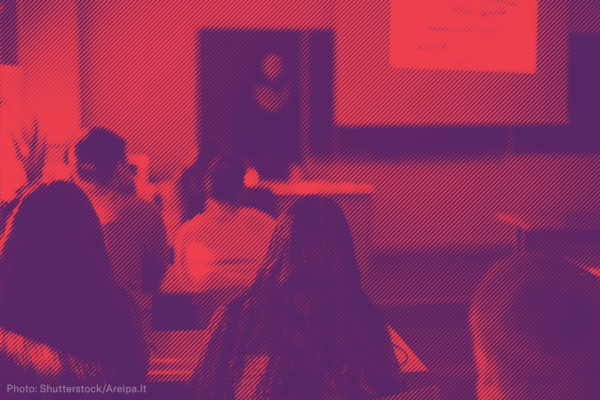When I was in middle school, I got some very basic sex ed. For one week, a very uncomfortable health/gym teacher taught me about body parts and reproduction, that sex — always heterosexual — can lead to pregnancy and sexually transmitted infections, and that we should therefore abstain from sex or use condoms. I was lucky because most people I know didn’t get the condom bit.
What I didn’t learn was key information and skills that would have equipped me to have healthy relationships. I didn’t learn about gender and power. I didn’t learn what consent meant and how to give, refuse, or make sure you have it. There was nothing about what sexual harassment is or how gender stereotypes play out in harmful ways. And I most certainly didn’t learn how to navigate the many unsafe, threatening, harassing, and violent situations I’ve experienced in the workplace and beyond. I wish I — and all the men who have harassed, demeaned, and harmed me — had.
This is a seismic moment of #MeToo and #TimesUp, which are unmasking behaviors most women routinely experience but have traditionally gone unpunished. This, in turn, has led to the start of real consequences, accountability, and solutions rooted in equity.
But we need to talk more about prevention. To stop the objectification of women and power imbalance that fuels this societal epidemic, we need to start long before anyone enters the workplace. If we want to be serious about making long-term cultural change to stop sexual harassment and violence, we should provide comprehensive sex ed in all of our schools.
Our knowledge of what makes for good sex ed has come a long way since I was in middle school. In 2011, dozens of experts came together to develop the first national learning standards for sexual health education. The standards are the “essential minimum” age-appropriate core content for K-12 students. They recommend students learn information and usable skills about identity and bias because it impacts how we feel about ourselves and how we interact with each other. This includes cultural gender roles, gender stereotyping, gender nonconformity, gender identity, and sexual orientation.
The standards say we should be learning how to maintain healthy and safe relationships and how to treat others with dignity and respect. In pursuit of these goals, the standards recommend teaching students how to communicate personal boundaries, how to recognize unhealthy and abusive relationships and sexual harassment, how to understand the role of power in relationships, and where to go for help in an abusive relationship, and how to stop bullying of others.
HAVE YOU BEEN HARASSED ON THE JOB? TELL US YOUR STORY.
Teaching this kind of comprehensive sex ed can have real impacts. A recent global study that included the United States shows that young people firmly believe and act upon gender stereotypes by at least age 10. Another recent study found including gender and power lessons in sex ed improved health outcomes and healthy behaviors. Abstinence-only education is a proven failure and frequently reinforces gender stereotypes that play out in our behavior.
In 2012, the New York Civil Liberties Union unearthed some horrific examples of gender stereotyping in sex ed lessons then in use in state schools. One lesson explained how men “want to conquer & dominate” whereas women try “to manipulate and control,” that men see “women as a trophy” whereas women see men as security and protector[s],” and that “Teenage boys want sex, teenage girls want love.” Some lessons, including textbooks, sent the message that girls are at fault for harassment or assault if they dress or act in a way that invites it. Boys were taught that this behavior is somehow innate because boys just can’t help themselves.
Armed with this knowledge, California took a big step in 2015, mandating sex ed in middle and high school for the first time through a law called the California Healthy Youth Act. The law, sponsored by the ACLU of California and a coalition of advocates, is groundbreaking, based on all the best science, and can serve as a model for what truly comprehensive and inclusive sex ed looks like. Students must be taught age-appropriate and medically accurate lessons and skills designed to equip them to have healthy, positive, and safe relationships. By doing so, the law aims to minimize gender and sexual orientation bias and stereotyping as well as foster a positive and healthy attitude toward sexuality.
The California Healthy Youth Act squarely addresses harassment and violence. Students learn about what consent constitutes, how to distinguish healthy from unhealthy relationships, and how to identify sexual harassment, sexual assault, dating abuse, and sex trafficking. Because providing information alone is not enough, students must also obtain concrete skills like how to recognize and navigate abusive situations and how to find local resources for help.
The law directly tackles bias and stereotyping that fuels the harassment and discrimination we experience in the workplace and beyond. It mandates teaching about gender, gender identity, and the harm of negative gender stereotypes. Same-sex couples must be depicted. Transgender and non-binary people cannot be erased. Accurate information about all contraception methods and pregnancy options, including abortion, must be taught, giving young people a greater ability to control their fertility and, relatedly, equality.
Schools are actively implementing the law, and time will tell how far it goes in helping to bring about true cultural change. But we in California hope it will serve as a useful model for people in other states looking for creative ways to tackle the underlying dynamics that fuel sexual harassment and violence before it starts.
Will comprehensive sex ed stop all predatory and misogynistic behavior? No. But will it make more people understand consent and boundaries? Will it make more people aware that gender bias and stereotyping hurts us all? Will it make us more prone to believe and support our friends and peers when they speak up and say, “I was harassed,” “I was assaulted,” “I was raped?”
Unequivocally, yes.
Learn more about California’s law and how to implement it in your school or advocate for something like it in your state.


